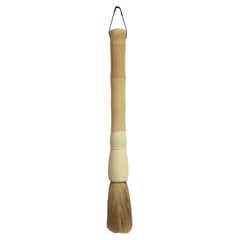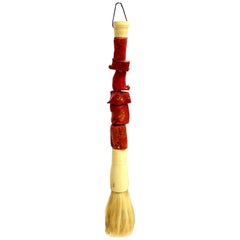Chinese Scholar's Objects
Color: Orange
Place of Origin: Chinese
Chinese Guangxu Coral Glazed Porcelain Brush Washer/Ink Well
Located in Bishop's Stortford, Hertfordshire
A fine antique Chinese coral glazed porcelain brush washer or inkwell decorated with a bamboo sprig and dating from the early Guangxu reign 1875-...
Category
1870s Qing Antique Chinese Scholar's Objects
Materials
Porcelain
Related Items
Chinese Qing Dynasty Guangxu Porcelain Vase
Located in New York, NY
Chinese Qing dynasty Jiaqing period porcelain vase with green glazed floral elements and scroll designs on a rich black glaze ground. Featuring bright yellow dragon...
Category
Late 19th Century Qing Antique Chinese Scholar's Objects
Materials
Porcelain
Chinese Calligraphy Brush Bone Handle
Located in Somis, CA
Beautiful Chinese calligraphy brush with handmade bone handle. A beautiful brush that is perfect for making art or as an design element. Bone ferrule and h...
Category
2010s Chinese Scholar's Objects
Materials
Bone
Antique Chinese Hand Carved Hardstone Brush Washer Archaic Ruyi Qing early 20
Located in Richmond, CA
This antique hand-carved sodalite hardstone brush washer is a stunning example of traditional craftsmanship and artistic expression. The washer is of a compressed barrel form, a shap...
Category
Early 20th Century Qing Chinese Scholar's Objects
Materials
Stone
Chinese Calligraphy Brush, c. 1900
Located in Chicago, IL
Along with paper, ink, and inkstone, the brush was part of the four treasures found in a scholar’s studio. Arguably the most important tool, the brush served as a direct link to the ...
Category
Early 20th Century Qing Chinese Scholar's Objects
Materials
Wood
Vintage Chinese Bone Calligraphy Brush
Located in Somis, CA
A beautiful Chinese calligraphy brush with handmade bone handle. This brush is from the 20th century but was not used. It is perfect for making art, calligraphy or as an design eleme...
Category
20th Century Chinese Scholar's Objects
Materials
Bone
Chinese Blue and White Porcelain Vase from Modern Official Kiln
Located in Atlanta, GA
Dubbed as production of the "Chinese Modern Official Kiln", a small group of porcelains of the highest standard were produced in Jingdezhen from 1962-1967, The production was aimed as a revival of the Chinese porcelain after the foundation of the Republic in 1949 in order to serve the purpose of decorating the meeting halls for the newly renewed diplomatic relations around the globe. The best available materials and artists, including the painters and potters, were employed to achieve a high quality that rivaled the pieces produced during the pinnacle years in the porcelain production in the previous Qing dynasty. Due to the breakout of the Cultural Revolution, most of the pieces failed to be used as intended. Most if not all signatures, such as found on this vase, were added later as a hallmark to distinguish them. "Zhong Nai Hai Huai Ren Tang Treasures Porcelain Research Bureau year of 1962". Zhong Nai Hai is the residential and working compound for Chinese political elites in Beijing and Huai Ren Hall being an important meeting hall.
The pieces from "Modern Official Kiln" ubiquitously showcase perfectly balanced forms with precision in symmetry. The use of very high quality Gaolin clay resulted in a semi translucent body, often quite thinly potted. The superbly underglaze paint were sandwiched between a pre-applied glaze and then an overglaze, and the elaborate designs were drawn by master painters. Often, there is a hidden red Chinese National Emblem on the interior wall. These features were all well reflected in this piece. The decoration of the blue paint on the vase is of a classic regal composition and the cobalt blue is of a vivid radiating color. Blooming peonies, an old laurel tree with blossom and scholar rocks provide the background and anchor for a pair of peasants. One raises its head to crow while the other one looks down. These motifs are commonly found in classic Chinese scroll paintings, a genre called "Flower and Bird Painting". On the back of the vase, there are Chairman Mao's head portrait watermarked in the glaze as well as a cursive poem with a collection number as shown.
For a pair of blue and white vase of the same production, see sale by Singapore International Auction PTE ltd on July 21st, 2019 lot 2014.
For a pair of blue and white urns...
Category
1960s Modern Vintage Chinese Scholar's Objects
Materials
Porcelain
Chinese Blue Glazed Brush Rest, c. 1900
Located in Chicago, IL
Set alongside the four treasures of the study - the calligraphy brush, ink, paper, and inkstone - a brush rest was an essential fixture of the scholars' desk. This early 20th century...
Category
Early 20th Century Qing Chinese Scholar's Objects
Materials
Ceramic
Chinese Antique porcelain ginger jar, South-East Asia, Guangxu 1900
Located in DEVENTER, NL
Chinese porcelain ginger jar with floral decorations in bright and vibrant colours, made for the South-East Asian market.
Made around 1900.
Dimensions: 25 x 22 x 22 cm.
Overall in good condition, some minor damage to the glaze and some minor frittings to the unglazed parts of the lid.
Possibly Peranakan or Straits Chinese ware...
Category
1890s Antique Chinese Scholar's Objects
Materials
Porcelain
Chinese Huanghuali Brush Pot
Located in Atlanta, GA
Chinese Huanghuali brush pot
18th century
Carved cylindrical Chinese scholar’s brush pot, composed from the extincted Huanghuali wood. Beautifu...
Category
18th Century Qing Antique Chinese Scholar's Objects
Materials
Wood
Chinese Zitan Brush Pot with Soapstone Inlay, c. 1900
Located in Chicago, IL
Set alongside the four treasures of the study - the calligraphy brush, ink, paper, and inkstone - a brush pot, or bitong, was an essential fixture of the scholars' desk. This beautif...
Category
Late 19th Century Qing Antique Chinese Scholar's Objects
Materials
Soapstone
19th Century Monumental Chinese Carved Rosewood Brush Pot
Located in Rio Vista, CA
Rare and unusual 19th century monumental Chinese rosewood brush pot carved from a large, solid trunk. Beautiful crafted with a subtle hourglass cylindrical shape. Featuring rich and ...
Category
19th Century Qing Antique Chinese Scholar's Objects
Materials
Rosewood
Japanese Glazed Ceramic and Silver Koro Incense Burner Makuzu Kozan
By Makuzu Kozan
Located in Atlanta, GA
A tri-pod ceramic incense burner (koro) by Japanese Imperial potter Makuzu Kozan (1842-1916) circa late Meiji to the start of Taisho period (1890-1910s). A fine example of the artist's work belonging to the late part of his underglaze paint phase (started around 1887 until his death), the surface of the koro was painted in beautiful shades of blue to depict a continuous landscape not unlike a traditional ink and watercolor hand scroll. The rise and fall mountains recede and fade into the horizon and are dotted with groves of pines. The sky is painted with a beautiful subtle shade of pink, suggesting a time of sunrise or sunset. The koro is fitted with an ensuite reticulated sterling silver hoya (incense cover), pierced with swirling cloud and marked with "pure silver' in Kanji. The base is signed in underglaze blue "Makuzu Kozan Sei" within a double ring. The piece is beautifully potted in form and the decoration was done with expertise using the novel technique developed by Kozan called Fuki-e (the blow painting), in order to achieve the striking landscape known as "Mountain and Water" with sense of dimensions and gradient, the poetic effects normally conveyed only by sumi ink staining on paper. The piece comes with an unsigned tomobako (wood storage box) of a recent age.
Also known as Miyagawa Kozan (1842–1916), Makuzu Kozan was one of the most established and collected ceramist from Meiji Period. Born as Miyagawa Toranosuke, Kozan established his pottery studio in Yokohama around 1870s and later became one of the appointed artists to the Japanese Imperial household. His work was exhibited in many international fairs that the Meiji government participated at the turn of the century and won many grand prizes. Being one of the most creative ceramists, Kozan started experimenting with new chemical colors from the West in the format of his porcelain glaze around 1880s. New colors allowed him to create underglaze designs that appeared bright, smooth and glossy. He even invented his own receipt of cobalt blue to achieve a much brighter yet softer shade, as evident on this vase. To create landscape that is realistic and dimensional, more common in the western paintings, he was inspired by the native Japanese ink painting technique developed around 1900 by Yokoyama...
Category
Early 1900s Japonisme Antique Chinese Scholar's Objects
Materials
Silver
Previously Available Items
Chinese Scholar's Meditation Stone
Located in Norwood, NJ
Mounted on a wood base, this is a large and impressive scholar's meditation stone. Meditating on the stone’s unique composition, the scholar found inspiration in the stone’s complexi...
Category
Late 20th Century Chinese Scholar's Objects
Materials
Stone
Red Faux Coral Calligraphy Brush
Located in Somis, CA
A beautiful one of a kind handmade calligraphy brush with vibrant red faux coral. Bone ferrule and horse hair.
Category
Late 20th Century Chinese Scholar's Objects
Materials
Resin, Bone
Ancient Chinese Hand-Carved Jade Bi Genuine Specimen from 2000 BC
Located in South Burlington, VT
This is an authentic Chinese ancient jade bi disc from the Qi Jia Culture, Northwestern China, 3,000-2,000 BCE. This comes from our private collection.
Including Our Certificate of...
Category
15th Century and Earlier Antique Chinese Scholar's Objects
Materials
Jade
Late 19th Century Chinese Bone Archer's Ring
Located in Chicago, IL
Hand carved of animal bone, this late 19th century Archer's ring was likely worn by a gentleman-scholar in northern China. Typically carved of jade, Chinese archers wore these rings ...
Category
Late 19th Century Qing Antique Chinese Scholar's Objects
Materials
Bone
Recently Viewed
View AllMore Ways To Browse
Antique Chinese Calligraphy Set
Japanese Scholars Box
Antique Chinese Inkstone
Archer Ring
Gongshi Stones
Lingbi Scholar Stones
Lingbi Stone
Carved Bone Horses
Taihu Rock
Brush Washer
Chinese Brush Holder
Qing Ink Stone
Antique Calligraphy Tools
Chinese Brush Washer
Calligraphy Brush Stand
Japanese Suiseki
Chinese Calligraphy Brush Stand
Chinese Calligraphy Brush And Stand




